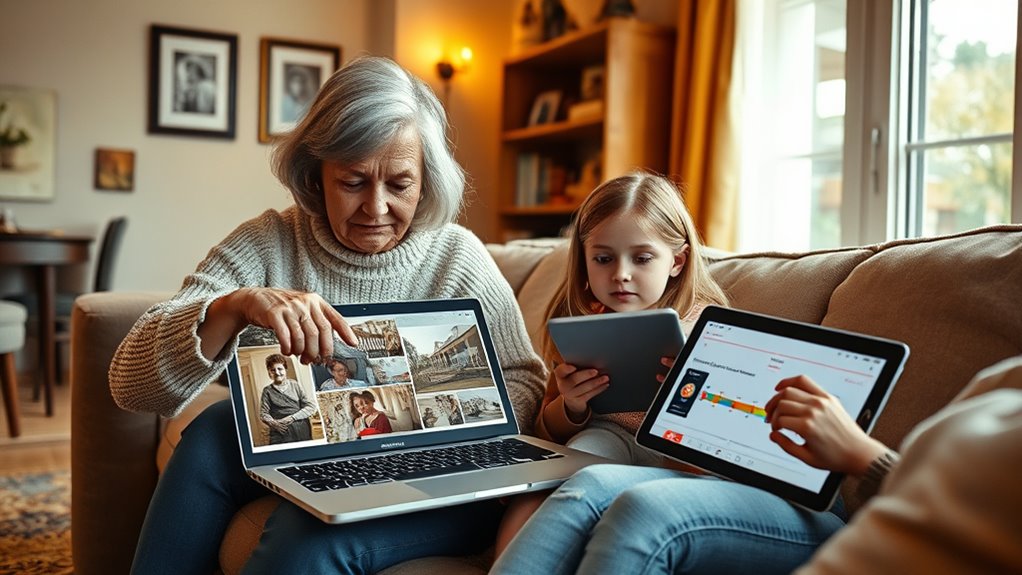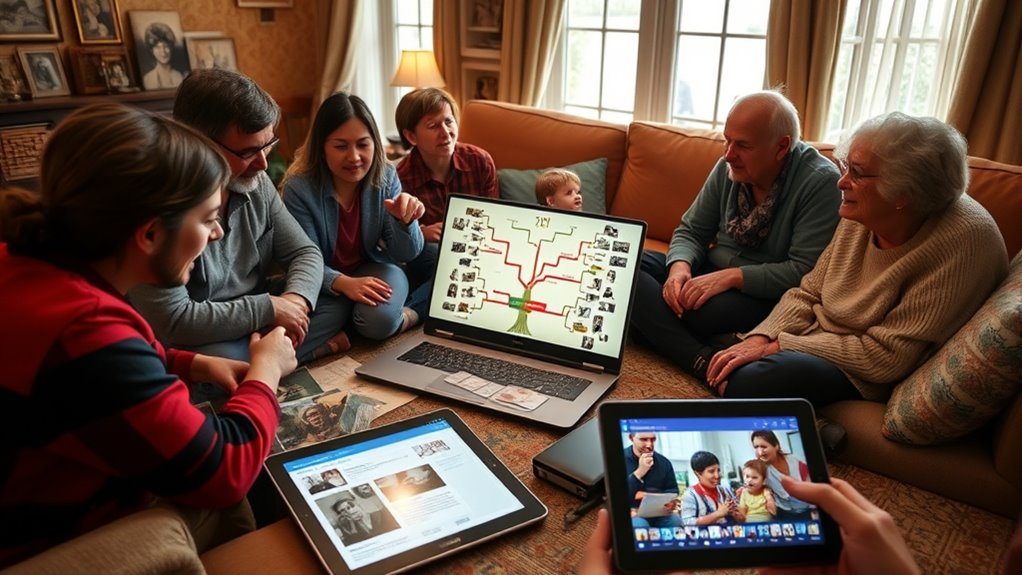Sharing your family history through digital storytelling allows you to transform cherished memories into engaging, multimedia narratives that connect generations. By combining photos, interviews, and written stories, you make family history more accessible and emotionally impactful. Encouraging family members to participate deepens the understanding of your heritage and creates a lasting legacy. If you keep exploring, you’ll discover simple ways to preserve and share these meaningful stories for years to come.
Key Takeaways
- Digital storytelling combines photos, audio, and text to create engaging, multimedia family history narratives.
- Incorporating oral histories captures personal voices and emotional connections to ancestors.
- Sharing stories online or via family websites broadens access and encourages intergenerational participation.
- Collaborative efforts with relatives enrich the narrative with diverse perspectives and additional content.
- Digital stories preserve family heritage in durable formats, ensuring stories are remembered and celebrated over time.

Sharing your family history helps keep your ancestors’ stories alive and strengthens your connection to the past. Digital storytelling is a powerful way to do this, allowing you to craft compelling narratives that resonate across generations. When you engage in genealogy research, you uncover details about your ancestors’ lives—birthplaces, occupations, struggles, and triumphs. These facts form the backbone of your stories, but it’s the oral storytelling aspect that truly brings them to life. By sharing these stories through digital media, you transform static facts into vibrant, relatable experiences that can be easily shared with family members near and far.
Using digital tools, you can combine photographs, recorded interviews, and written narratives to create multimedia stories. This approach makes your family history more engaging and accessible. For example, you might record a relative recounting their childhood memories or narrate a story based on your genealogy research, then pair it with old photos or documents. This multimedia format appeals to different learning styles and keeps your audience captivated. Plus, it preserves your family stories in formats that are unlikely to fade over time, unlike paper or oral traditions alone.
Oral storytelling plays an essential role in digital storytelling because it captures emotion, voice, and personality—elements that static documents often lack. When you record family members sharing their memories, you preserve their voice and unique perspective. These recordings become invaluable heirlooms that future generations can listen to and connect with on a deeper level. Incorporating these recordings into digital stories creates a personal link to your ancestors, making history feel immediate and real. It’s a way to honor their experiences and pass them down authentically. Additionally, understanding the importance of air quality can help you create a comfortable environment for recording family stories, especially if allergies or respiratory issues are a concern.
Creating digital stories also encourages family participation. You can invite relatives to contribute photos, videos, or personal anecdotes, making the process collaborative. This shared effort deepens your collective understanding and appreciation of your heritage. Furthermore, sharing your stories online or through family websites ensures they reach a broader audience, allowing relatives who live far away to engage with their roots. This digital sharing can inspire younger family members to take an interest in genealogy research, fostering ongoing curiosity about their history.
In essence, digital storytelling turns your family history into a dynamic, living legacy. It combines your genealogy research with oral storytelling to craft narratives that are emotionally compelling and visually rich. By embracing this approach, you guarantee that your ancestors’ stories won’t just be recorded—they’ll be remembered, celebrated, and passed on with impact.
Frequently Asked Questions
What Digital Tools Are Best for Storytelling?
When choosing digital tools for storytelling, consider options that excel in photo editing and multimedia integration. Apps like Adobe Spark or Canva let you easily edit photos and combine videos, audio, and text into compelling stories. These tools are user-friendly and versatile, helping you craft engaging narratives. By focusing on photo editing and multimedia integration, you can create dynamic stories that captivate your audience and preserve your family history effectively.
How Can I Verify Family History Accuracy?
Imagine you’re scrolling through your smartphone, trying to verify your family history. To guarantee accuracy, you should compare oral traditions with historical records, like census data or birth certificates. Cross-referencing these sources helps you spot inconsistencies and confirms details. Don’t forget, even with digital tools, the key is to critically evaluate each piece of information, blending storytelling with solid research to preserve your family’s true story.
What Privacy Concerns Exist With Digital Sharing?
When you share family history digitally, you face privacy risks like exposing sensitive information to unintended audiences. Data security becomes vital to protect personal details from hackers or misuse. Always consider who can access your content, use strong passwords, and avoid sharing overly personal data publicly. Being aware of these privacy risks helps you safeguard your family’s history while still sharing meaningful stories responsibly.
How Do I Engage Younger Family Members?
To engage younger family members, you should incorporate interactive activities and storytelling techniques that appeal to their interests. Use multimedia elements like videos, photos, and music to make stories more dynamic. Encourage them to participate by sharing their own memories or creating digital stories. Keep the process fun and relatable, making it a collaborative experience. This approach helps foster interest and connection with family history in an engaging, modern way.
What Are Cost-Effective Ways to Start?
You can start easily and affordably by focusing on photo preservation and oral history. Use your smartphone or free apps to digitize old photos and record family stories. Encourage family members to share memories in casual conversations, then compile these recordings into simple digital stories. You don’t need expensive equipment—just some basic tools and a little creativity to preserve and share your family’s history cost-effectively.
Conclusion
Sharing your family history through digital storytelling allows you to connect generations and preserve memories creatively. Did you know that over 70% of people feel more connected to their roots after exploring family stories online? By embracing digital tools, you turn cherished memories into lasting stories that inspire future generations. So, start sharing today—you’ll not only keep your family’s legacy alive but also create a meaningful bond that lasts for years to come.








